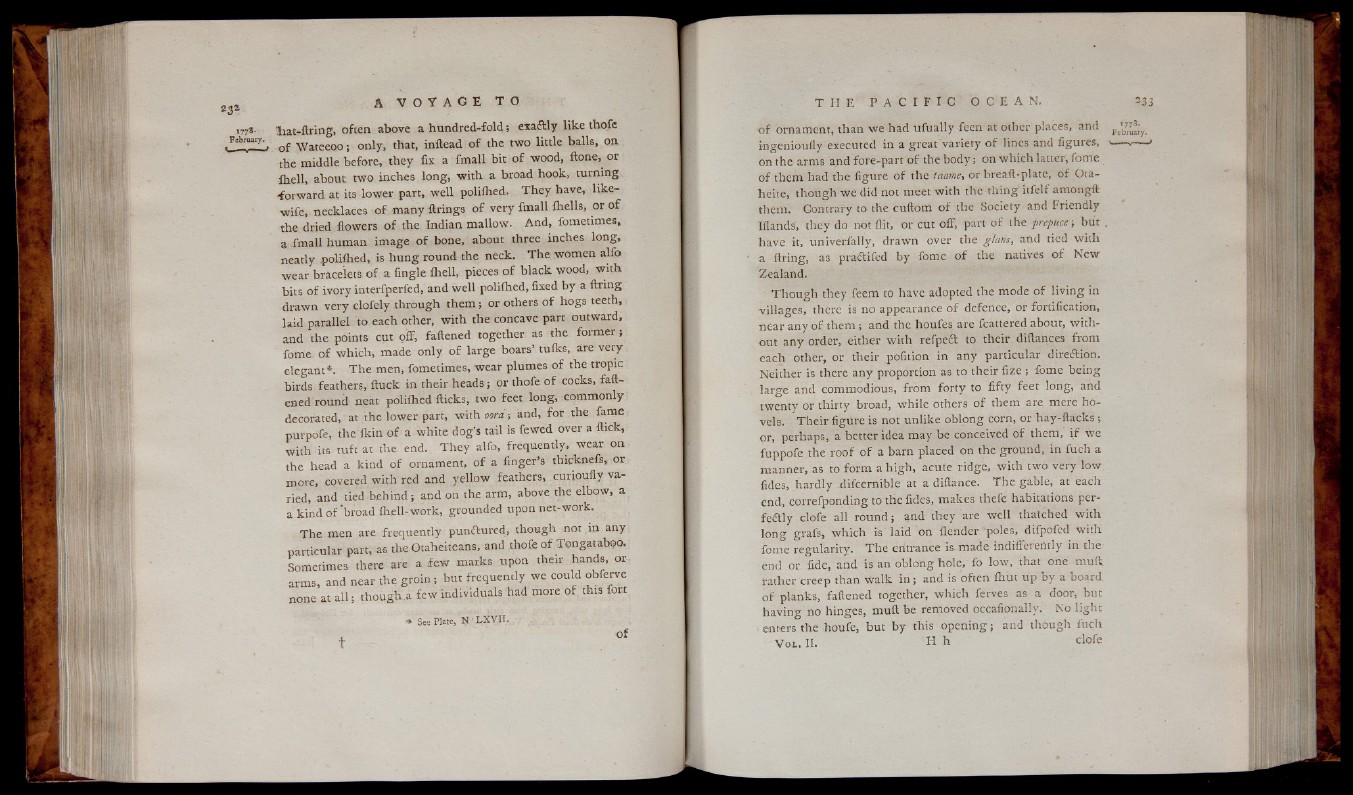
17/8- tiat-ftrin g, often above a hundred-fold; exa&ly lik e thofe
February.. ^ \y ateeq o ; only, that, inftead o f the two little balls, on
the middle before, they fix a fm a ll bit o f wood, ftone, or
ih e ll, about two inches long, w ith a broad hook, turning
•forward at its lower part, well poliihed. T h e y have, lik e -
wife , necklaces o f many firings o f ve ry fmall fliells, or o f
the dried flowers o f the Indian mallow. And, fometimes,
a fmall human ima ge o f bone, about three inches long,
neatly poliihed, is h u n g round the neck. T h e women alfo
wea r bracelets o f a Angle ihell, pieces o f bla ck wood, w ith
bits o f ivory interfperfed, and well poliihed, fixed by a firing
drawn ve ry clofely through th em ; or others o f hogs teeth,
laid parallel to each other, with the concave part outward,
and the points cut off, fattened together as the fo rm e r ;
fome o f which, made only o f large boars’ tuiks, áre ve ry
elegant*. T h e men, fometimes, wea r plumes o f the tropic
birds feathers, flu ck in their h e ad s ; or thofe o f -cocks, fattened
round neat poliihed fticks, two feet long, commonly
decorated, at the lower part, with tora; and, fo r the fame
purpofe, the ikin o f a white dog’s tail is fewed over a ftick,
with its tuft at the end. T h e y alfo, frequently, wear on
the head a kind o f ornament, o f a finger’s thipknefs, or
more, covered with red and 3'ellow feathers, curiouily va ried,
and tied b eh in d ; and on the arm, above the elbow, a
a kind o f ’broad ihe ll-work, grounded upon net-work.
The men are frequently punCtured, though not in any
particular part, as the Otaheiteans, and thofe o f Tongatabqo.
Sometimes there are a f ew marks upon their hands, or-
arms, and near the groin.; but frequently we could obferve
none at a l l , though a f e w individuals had more o f this fort
t
i# See Plate, N | LX V .II .
o f
o f ornament, than we had u fu a lly feen at other places, and
ingenioufly executed in a great variety o f lines and figures, 1— -v-—
on the arms and fore-part o f the b o d y ; on w hich latter, fome
o f them had the figure o f the taame, or breaft-plate, o f Ota-
heite, though w e did not meet with the thing itfelf amongft
them. Contrary to the cuftom o f the Society and Friendly
Iflands, they do not flit, or cut off, part o f the prepuce; but .
have it, univerfally, drawn oyer the ¿-Mr, and tied with
a firing, as praftifed b y fome o f the natives o f New
Zealand.
T h o u g h they feem to have adopted the mode o f liv in g in
v illa g e s , there is no appearance o f defence, or fortification,
near any o f them ; and the houfes are fcattered about, w ith out
any order, either w ith refpeft to their diftances from
each other, or their pofition in any particular direction.
Neither is there any proportion as to their fize ; fome being
large and commodious, from forty to fifty fee t long, and
twenty or thirty broad, w h ile others o f them are mere hovels.
The ir figure is not un like oblong corn, or hay-ftacks ;
or, perhaps, a better idea may be conceived o f them, i f we
fuppofe the ro o f o f a barn placed on the ground, in fuch a
manner, as to form a h igh , acute ridge, with two very low
fides, hardly -difcernible at a diftance. T he gable, at each
end, correfponding to the fides, makes thefe habitations perfe
c tly clofe all ro u n d ; and they are w e ll thatched with
lo n g grafs, w hich is laid on flender 'poles, difpofed with
fome regularity. T he entrance is made indifferehtly in the
end or fide, and is an oblong h o le ,'fo low, that one muff
rather creep than w a lk i n ; and is often ihut up b y a board,
o f planks, fattened together, which ferves as a door, but
ha vin g no hinges, muft be removed occafionally. No ligh t
enters the houfe, but b y this op en in g ; and though fuch
V ol. II. H h clofe